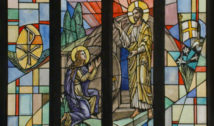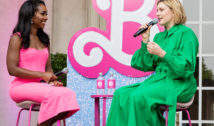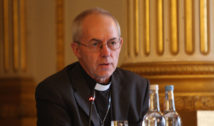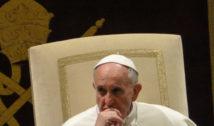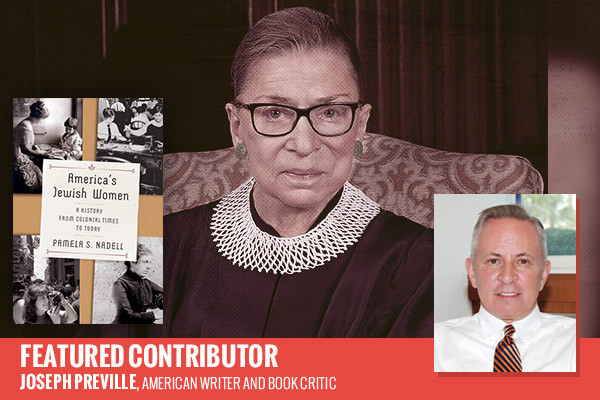
How American Jewish Women Shaped American Culture: An Interview with Pamela S. Nadell
- By Joseph Preville --
- 08 Jul 2019 --
![Ruth Bader Ginsburg Supreme Court of the United States [Public domain], via Wikimedia Commons](https://www.worldreligionnews.com/wp-content/uploads/2019/04/JPrevilleNadell.jpg)
How American Jewish Women have left a legacy that reverberates across American history.
For more than three and a half centuries, Jewish women have paved a road for themselves to thrive in the United States. Their long and fascinating journey is the subject of Pamela S. Nadell’s excellent new book, America’s Jewish Women: A History from Colonial Times to Today (W. W. Norton & Company, 2019). Nadell holds the Patrick Clendenen Chair in Women's and Gender History and is Director of the Jewish Studies Program at American University. She is the author of Women Who Would Be Rabbis: A History of Women's Ordination, 1889-1985 (Beacon Press, 1999). In her new book, Nadell shows how Jewish women have not only shaped American Judaism, but American culture as a whole. “America’s Jewish Women,” she writes, “brings to life some of those who, making their marks in different fields – education, politics, industry, labor, journalism, health care, charity work, popular culture – left a legacy that reverberated across American history.”
Professor Pamela S. Nadell discusses her new book in this interview.
Joseph Richard Preville: Why is it important to study the lives and experiences of American Jewish women?
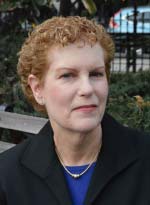
A long time ago, a colleague, contemplating venturing into American Jewish women’s history, told me that he assumed that everything to say had already been said. My reply was “hardly.” But I understood his subtext. He conceded: American Jewish women have a history. But really how much history can they possibly have?
His stance was typical of the men writing history across the millennia. They too had presumed that women’s lives, bounded by their families, had changed little across the ages. In uncovering the breadth, depth, and diversity of this history, America’s Jewish Women shows just how wrong they were.
How American Jewish Women Shaped American Culture: An Interview with Pamela S. Nadell[/tweetthis]
JRP: How did American Jewish women nudge their religious communities to embrace change, equality, and inclusivity?
PSN: Even in colonial days, we see Jewish women nudging Judaism into the future. From New York the traditionally observant Abigail Levy Franks (1696-1756) audaciously criticized Judaism’s idle ceremonies, writing that, if a “Calvin or Luther” would arise among the Jews, she would be among the first of their followers.
Since then, America’s Jewish women, speaking as individuals and through their powerhouse women’s organizations have continued to challenge Jewish men gathering in their synagogues and Jewish communal associations to hear women’s voices and embrace female equality. We only have to look about us today at the women who became Reform, Conservative, and even a few Orthodox rabbis to see just how much Jewish life has changed.
JRP: You write that “Hewing to a life-long road of learning and reading became a distinguishing trait of America’s Jewish women.” Why did Jewish women place great importance on learning and education?
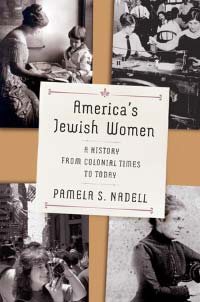 PSN: More than a century ago, Jewish immigrants coming to America from Eastern Europe embraced education as the road out of the teeming ghetto. For immigrants and their American-born children, education in this nation’s free public schools paved that road. As memoirist Mary Antin wrote in 1912, the day that she, a poor immigrant, entered public school, she “took possession of America.”
PSN: More than a century ago, Jewish immigrants coming to America from Eastern Europe embraced education as the road out of the teeming ghetto. For immigrants and their American-born children, education in this nation’s free public schools paved that road. As memoirist Mary Antin wrote in 1912, the day that she, a poor immigrant, entered public school, she “took possession of America.”
Yet, even before then, Jewish women, demonstrated their desire for life-long learning. In 1879, in St. Louis, Rosa Sonneschein, a rabbi’s wife, gathered her friends in a neighbor’s parlor and founded the Pioneers, a Jewish women’s reading group. Astonishingly, it still meets today. Back in 1970, as its Future Directions Committee was deciding that Jewish ethnicity and religion were irrelevant for vetting new applicants, the Pioneers declared that all that was required for membership was for a “girl” to want to learn.
JRP: What motivated Jewish women to play a prominent role in establishing and supporting philanthropic and social service organizations in the United States?
PSN: Tradition, America, and hardship propelled Jewish women into philanthropy and social service. They hailed from lands where tradition had women look after their own. As immigrants, they arrived in a nation as a myriad of local, regional, and national organizations sprang up to care for the poor, the widowed, the orphan, the sick. Whenever Jewish women encountered a need, they acted. In their homes and synagogues, they gathered to help the widowed peddler whose basket was unemptied at the end of the day and to sew layettes for needy mothers.
As America grew, the problems grew. Not long after the National Council of Jewish Women was organized in 1893, it took up the fight against white slavery to prevent girls and women traveling to America on their own from falling into the hands of evil men.
JRP: What are some of the major social causes Jewish women championed in American history?
PSN: Zionism, civil rights, and feminism jump out as a triumvirate of social causes that engaged great swathes of America’s Jewish women. Early in the twentieth century Daughters of Zion groups began meeting in cities across America, but it took the genius of Henrietta Szold to harness them into Hadassah, the Women’s Zionist Organization of America. In 1909, at nurse Lilian Wald’s Lower East Side Henry Street Settlement, the NAACP (National Association for the Advancement of Colored People) was founded. It is stunning to read the litany of Jewish names leading the feminist way in the 1960s. Betty Friedan, author of The Feminine Mystique (W. W. Norton & Company, 1963), would acknowledge what others too would voice, that the antisemitism that she had faced as a Jew led her to realize the discrimination that she faced as a woman.
JRP: Why do you think U.S. Supreme Court Associate Justice Ruth Bader Ginsberg became a pop culture icon in America?
PSN: Ruth Bader Ginsburg was an icon for many of us from the moment she began taking up cases to end discrimination on the basis of sex in American law. She became a pop culture icon when a second-year law student at New York University coined the “Notorious RBG” to promote Justice Ginsburg’s dissenting opinion in a case that ruled part of the 1965 Voting Rights Act unconstitutional. As we all know, since then there have been t-shirts and coffee mugs, books and films (documentary and feature) about this diminutive woman whose towering intellect and brilliant judicial opinions have made her a giant in our time.
JRP: Could you recommend a few books on the history of Jewish women in the United States?
PSN: Fine books spotlight America’s Jewish women’s politics. In Radical Jewish Feminism: Voices from the Women’s Liberation Movement (New York University Press, 2018), Joyce Antler interviewed some of the feminists of the 1960s to tease out the salience of their Jewish backgrounds. In Ballots, Babies, and Banners of Peace: American Jewish Women’s Activism, 1890-1940 (New York University Press, 2013), Melissa R. Klapper uncovers the breadth of Jewish women’s campaigns for suffrage, birth control, and peace.
I also find memoirs and novels insightful illuminators of this history. Kate Simon’s evocative memoir Bronx Primitive: Portraits in a Childhood (Harper & Row, 1982), the first volume in her trilogy, hauntingly captures the moment when her mother stopped lighting Sabbath candles. Laurie Colwin’s novel Goodbye without Leaving (Poseidon, 1990) tells the story of the spiritual journey of a “relentlessly assimilated” Jewish backup singer for a black girl group.









